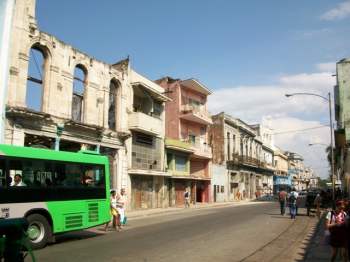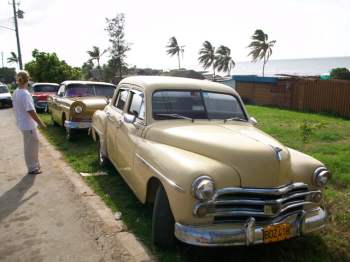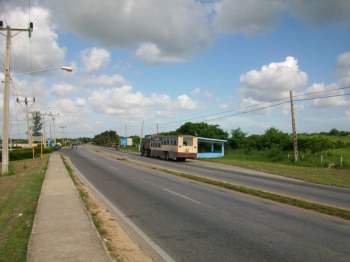A Cuba Urban Bus Terminal Scene
Graham Sowa

The slow drone of idling diesel engines and their steady exhaust serve as a backdrop for all other sensations at Terminal Playa, the main city bus interchange in western Habana.
The interchange is out of place in Playa. This is a neighborhood of Havana usually defined by the opulent houses of embassies, a series of hotels along the waterfront, various shopping centers catering to tourists and Cubans with disposable convertible pesos, and a handful of middle class locals.
Of course there are always exceptions to the usual characterizations of places, and for Playa, that is exactly what the bus terminal is.
The terminal is actually just an avenue just off of 5th Avenue, the main thoroughfare in western Habana. The oily and dusty streets are divided by a wide strip of dirt and its broken sidewalk. Some grass still clings to life.
The few trees seem powerless to block out the summer sun. Shade is a commodity usually held by those who can’t afford to go anywhere else, and lean against something to catch a nap or maybe sleep.
Rush hour at Terminal Playa is reminiscent of Dziga Vertov´s quick city scenes from his documentary The Man With the Movie Camera. Freeze any one scene and set about to identify all of the elements, movements, and emotions within; it would take hours.
Busses stop in the middle of the traffic circle to let pleading commuters disembark in hazardous conditions so they can run after their next bus before it speeds away. I don’t blame them, as a missed bus can mean a long, hot wait for the next.

Asides from the streets being full of busses and people chasing after them there are maquinas to all parts of Havana.
“La’bana Linea! La’bana Linea! La’bana Linea!”
“La’bana! 23, La’bana! 23, La’bana! 23”
“Capitolio!Capitolio!Capitolio!”
Barkers for the maquina drivers shout towards tired workers and the out of place foreigners, advertising the different routes.
The maquinas occupy all of the space along the curb not used for the busses, waiting for their chance to load up with passengers. They add to the cacophony with grinding transmissions and sound systems blaring reggaeton as they spew smoke and lumber away with a full load.
A few stray dogs (or maybe house pets set loose to feed themselves during the day) wonder along the sidewalk looking for discarded cafeteria food from the dozen or so fast food places selling thin sandwiches or pizza with transparent toppings.
If the diesel fumes do not induce nausea the waves of odor from boiling week old grease just might.
From behavior and appearance most everyone is used to the smells, the grime, and the noise. People stand and wait with a distant gaze and tired faces. Many do not even respond when someone looks for the end of a line by shouting ‘último!!!’.

Only the crowds of school children and groups of people coming from the waterfront in their bathing suits are busy chatting and laughing. I see several people with headphones, doing their best to cope.
Departing Terminal Playa might involve a wait of five minutes or hours, depending on planning and luck. At rush hour the lines are long and the busses are filled until absolutely no one else tries to squeeze into the door.
The cost for the bus is 40 centavos, but change in centavos is almost impossible to come by. Most of us just pay a peso and let it count for two people. Some don’t pay, and just walk aboard or sneak in one of the back doors of the bus.
I always wonder where my money goes when the conductor insists I put it in his hand rather than the fare box in the front of the bus. I have a suspicion that those handfuls of loose change have a destination far from any bus station.






A Mondragon-type, worker-owned cooperative bus enterprise would solve the problems of both riders and bus service workers. The Communists should be cooperative entrepreneurs, rather than bureau trolls.